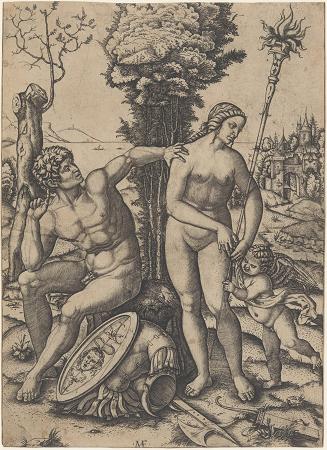Marcantonio Raimondi (1475 - 1534). Marcantonio Raimondi, often called simply Marcantonio, was an Italian engraver, known for being the first important printmaker whose body of work consists largely of prints copying paintings. He is therefore a key figure in the rise of the reproductive print. He also systematized a technique of engraving that became dominant in Italy and elsewhere. His collaboration with Raphael greatly helped his career, and he continued to exploit Raphael's works after the painter's death in 1520, playing a large part in spreading High Renaissance styles across Europe. Much of the biographical information we have comes from his life, the only one of a printmaker, in Vasari's Lives of the Artists. He is attributed with around 300 engravings. After years of great success, his career ran into trouble in the mid-1520s; he was imprisoned for a time in Rome over his role in the series of erotic prints I Modi, and then, according to Vasari, lost all his money in the Sack of Rome in 1527, after which none of his work can be securely dated. Marcantonio's date of birth is unknown, but was by 1482 at the latest. He was possibly born in Argine, near Bologna, Italy, where he is assumed to have grown up. He trained in the workshop of the leading goldsmith and painter in Bologna, Francesco Francia. Vasari claimed that Marcantonio quickly demonstrated more aptitude than Francia, and started designing and producing fashionable waist-buckles in niello. This is doubted, however, by Arthur Mayger Hind, who sees no evidence of a background in niello technique in his early engravings. No paintings produced by Marcantonio are known or documented, although some drawings survive. His first dated engraving, Pyramus and Thisbe, comes from 1505, although a number of undated works come from the years before this. From 1505-11, Marcantonio engraved about 80 pieces, with a wide variety of subject matter, from pagan mythology, to religious scenes. His early works use his own compositions, combining elements from Francia and other North Italian artists, and like all Italian printmakers in these years he was strongly affected by the enormously accomplished prints of Durer, which were widely distributed in Italy. Like other printmakers such as Giulio Campagnola, he borrowed elements of Durer's landscapes in a cut and paste fashion, and also borrowed from his technique. Durer was in Bologna in 1506, as was Michelangelo, and he may have met one or both of them. About this time he began to make copies of Durer's woodcut series, the Life of the Virgin. This was extremely common practice, although normally engravers copied other expensive engravings rather than the cheaper woodcuts. However Durer's woodcuts had raised the standard of the medium considerably, and since Marcantonio continued to copy a large number of both Durer's engravings and woodcuts, he must have found it profitable. His early copies included Durer's famous AD monogram, and Durer made a complaint to the Venetian Government, which won him some legal protection for his monogram, but not his compositions, in Venetian territory-an important case in the slowly evolving history of intellectual property law. Marcantonio appears to have spent some of the last half of the decade in Venice, but no dates are known. Around 1510, Marcantonio travelled to Rome and entered the circle of artists surrounding Raphael. This influence began showing up in engravings titled The Climbers.
more...













